ABSTRACT
With modern technology’s progress, the sharing economy model has become a business model actively popularized by various industries. The shortage and aging of the agricultural labor force have created an opportunity to accelerate the development of agricultural machinery sharing. Units under the Council of Agriculture have also established a system platform to assist farmers in deploying and matchmaking of agricultural machinery, expanding its service functions and conveniences. Non-governmental enterprises have also transformed vegetable vacuum pre-cooling and spraying services with drones into a model of agricultural machinery sharing. Finally, it is proposed that the future feasible agricultural machinery sharing can be divided into two types of sharing models: single machine and machine plus personnel, which can closely match the most suitable needs as well as the development of the industrial sector.
Keywords: agricultural machinery, Sharing Economy Model, farming service, pre-cooling equipment, drone spraying, dry lease, wet-lease
INTRODUCTION
In Taiwan, agricultural production is relatively small in scale, and the single producer resources are often limited. In contrast, a sharing economy model can be utilized in agriculture in terms of land, logistics, human resources and capital, and can lower the market entry barrier. In recent years, countries around the world have been facing a shortage of agricultural labor and aging issues, resulting in a significant increase in demand for agricultural mechanization and automation. Moreover, many agricultural machines are with high prices, plus their operating costs such as insurance, depreciation, maintenance, and storage are additional expenses after purchase. Apart from the cost of lands, the most significant cost of agricultural operation is agricultural machinery and equipment. Due to the change of demand and the development of the ICT industry, simple mechanization can no longer meet the needs of agricultural development, while agricultural machinery is gradually moving toward automation, motorization, and the integration of electrical and mechanical applications. To facilitate the development of Taiwan’s agricultural machinery sharing model, this paper introduces the international trend of sharing economy and current cases in Taiwan and explores the current development status of agricultural machinery sharing to establish a model which could be further developed based on such concept as a reference for future policy promotion.
SHARING ECONOMY DEVELOPMENT
With the increasing popularization of technologies and products such as the Internet of Things (IoT), big data, and mobile devices, sharing has become a business model aggressively pursued by various industries in recent years. According to a study, the total volume of sharing economic transactions in Europe in the areas of accommodation, transportation, work outsourcing services, and finance is estimated to proliferate from US$31.6 billion in 2015 to US$641 billion by 2025 (PwC, 2016), suggesting a rapid increase in the number of participants using sharing platforms for transactions. In addition, China has also actively set policies and targets for sharing economy promotion. In 2020, despite the impact of the COVID-19 pandemic, transactions in the sharing economy have still reached US$533.8 billion, with an overall growth rate of 2.9% compared to 2019 (Table 1), demonstrating the demand and potential of the sharing economy.
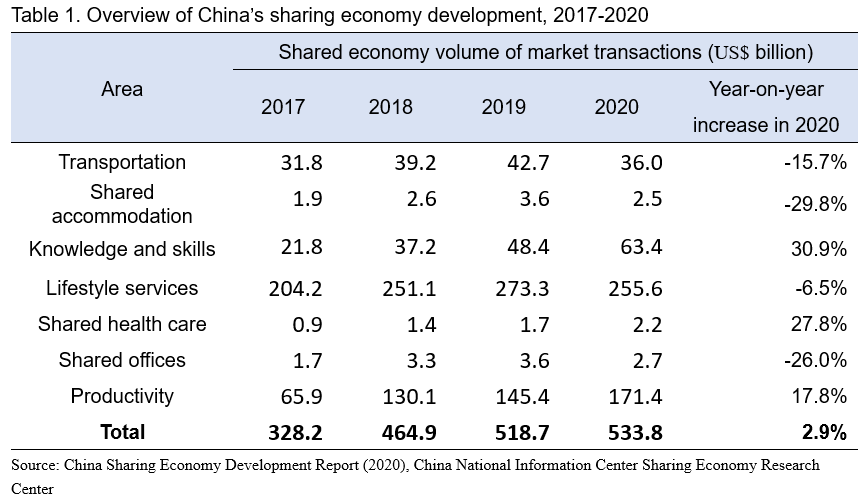
USAGE AND SHARING OF TAIWAN GOVERNMENT’S AGRICULTURAL MACHINERY
Taiwan’s agricultural sector is predominantly composed of small-scale farmers with a wide variety of crops and different crop growth periods. Large-scale agricultural machineries such as tractors and combined harvesters can cost tens to hundreds of thousands of US dollars (Figure 1); thus, maximizing the efficiency of these machines is a significant concern for farmers, while effective resource allocation across regions remains a significant challenge. Although small and medium-sized agricultural machinery may not command high prices, the cost of purchasing all agricultural machinery can be as high as US$3,200 to US$107,600 (Figure 2) depending on the type of land preparations, fertilization, pruning, harvesting, and transporting equipment required for different crops. However, many small agricultural machineries purchased are used only once or twice a year and are left idle for the rest of the year. It has led people to consider ways to replace ownership with access and reduce cost through sharing of agricultural machineries, leading to the gradual adoption of the sharing economy in the agricultural sector.
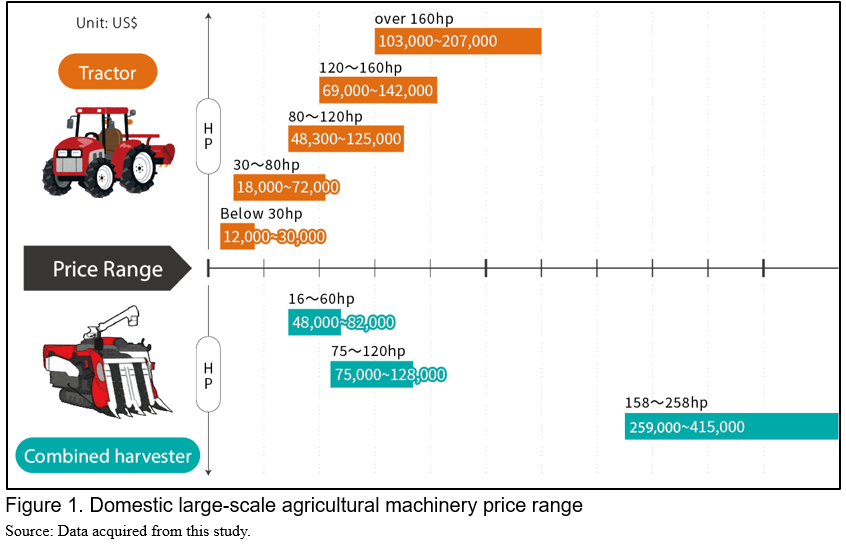
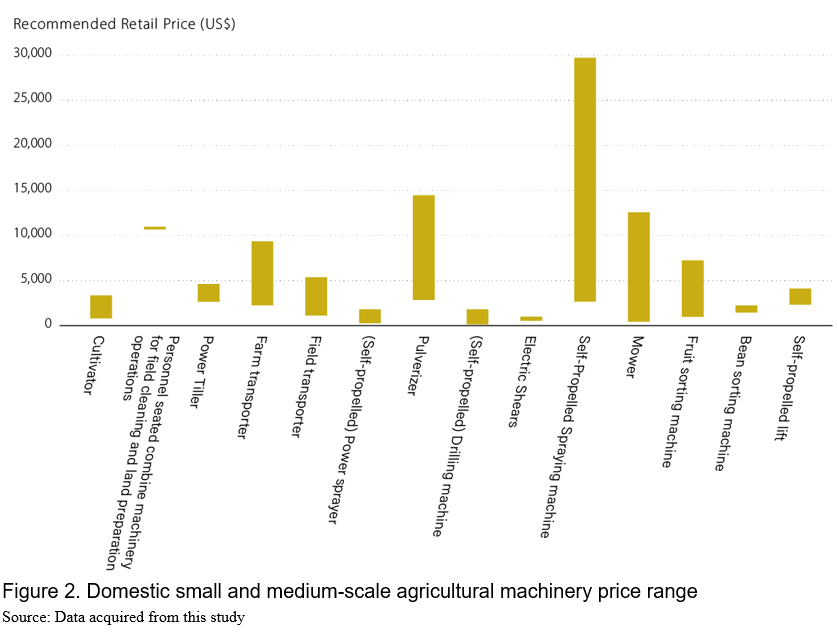
At present, in terms of the degree of automation of agricultural operations in Taiwan, the rice industry is the most well-established, with the degree of automation reaching 98%. In 2018, the Agriculture and Food Agency of the Council of Agriculture (COA) developed the Agricultural Machinery Farming Service Platform (also known as Agricultural Machinery Uber, https://eoi.afa.gov.tw/) on the basis of existing agricultural machinery farming networks. The platform assists farmers in all regions to locate the local operators through the website, improving the efficiency of agricultural machinery utilization and enhancing agricultural automation. At the same time, the Agency provided support to 14 counties and cities to establish “Agricultural Machinery Farming Service Associations,” of which more than 2,500 farmers are now members. In contrast, the associations can provide services such as deployment and matchmaking to meet farmers’ needs. For the purpose of expanding the functions and convenience of agricultural machinery services, farmers can also select agricultural services through the “Good Helpers for Agricultural Shortage” APP and the “Human Resources Platform” website (https://ahr.coa.gov.tw/), and rent the contents of farming services by selecting individual machines and human-machine combos, as shown in Figure 3.
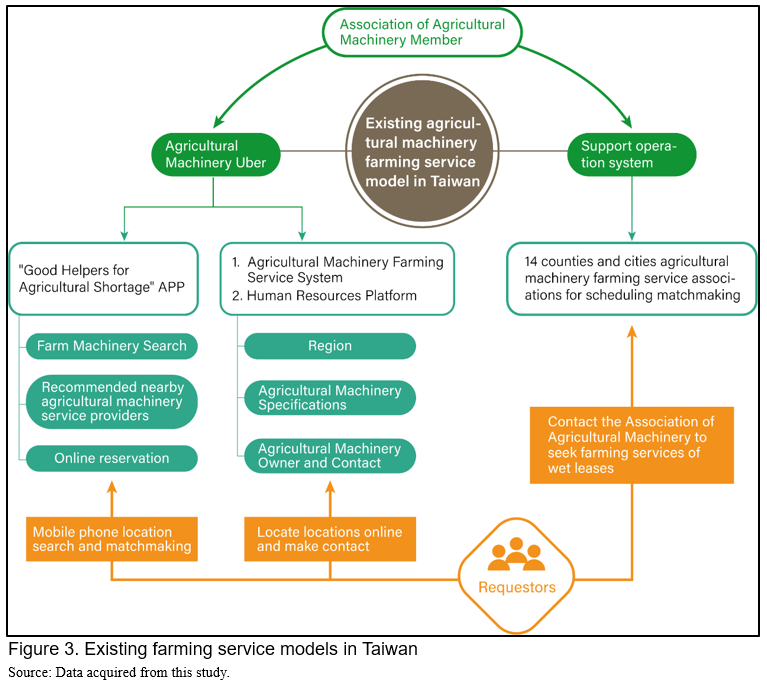
USAGE AND SHARING OF AGRICULTURAL MACHINERY BY TAIWAN ENTERPRISES
Currently, a number of cooperatives and enterprises in Taiwan have already been planning and implementing agricultural machinery sharing. In particular, most of the agricultural machinery with the high unit price and low utilization rate can be economically shared to resolve the issue of idle assets, whereas the operation of some agricultural machinery requires professional personnel, so the agricultural machinery sharing model has gradually incorporated the element of human resources outsourcing. The following paragraphs will introduce two cases of agricultural machinery sharing in Taiwan and analyze their operation models.
Yunlin Xinshe Fruit and Vegetable Production Cooperative
Yunlin Xinshe Fruit and Vegetable Production Cooperative mainly targets the small farmers producing leafy vegetable crops. Due to the rather hot weather in Taiwan, if the field heat of fruits and vegetables is not removed right after their harvest, it will result in rapid yellowing and rotting of leafy vegetable crops. Therefore, it requires complete pre-cooling equipment and cold chain storage to extend the storage and shelving time. However, the high price of vacuum pre-cooling machines (costing US$276,000) is not affordable to small-scale farmers. Therefore, Yunlin Xinshe Fruit and Vegetable Production Cooperative established an online system platform that provides complete information such as online rental reservation, reservation scheduling, cold chain storage space purchase, real-time quotation, remote monitoring, access information records, etc. In addition, pre-cooling machine usage time and cold storage space can be reserved by APP and calculated by the number of boxes or pieces. This allows farmers to receive timely and transparent quotations. Moreover, some farmers do not have a large volume of vegetables after harvesting and need to pool them with other farmers to use them together, and this system allows the vacuum pre-cooler to be used with maximum efficiency (Figure 4).
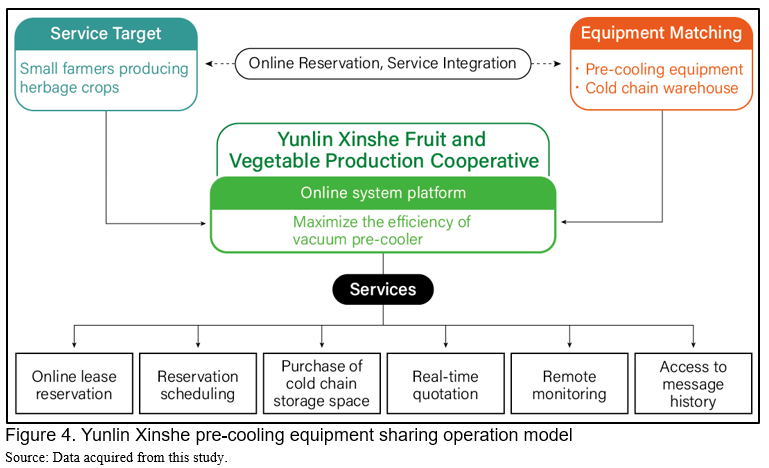
Lanlix Corp Science Co., Ltd
Lanlix is a manufacturer and sales company of pesticides and fertilizers. The decline of Taiwan's agricultural population has led to a shortage of human resources and an aging population, and pest and disease control operations are gradually replacing human resources with drones. However, the following difficult points have been identified: (1) It's hard for the Bureau of Animal and Plant Health Inspection and Quarantine to monitor the flow direction of pesticides accurately; (2) Sprayers or individual operators cannot be reported accurately to the Civil Aeronautics Administration (CAA); (3) It is difficult to find suitable operators or individual pilots, often resulting in crop damage and injury. For this reason, Lanlix has designed a two-way supply and demand matching platform for agricultural spraying with plant protection drones, which helps to match the demand and supply terminals quickly. On the other hand, the spraying operators or individual pilots can get the commissioning information directly from the platform, reducing the error of communication. In addition, the platform can connect to the database of CAA and the Bureau of Animal and Plant Health Inspection and Quarantine for easy data uploading and traceability.Finally, this matchmaking platform establishes the offline connection between the pesticide agents and the plant disease and pests control system of Lanlix, and uses the technical support of pest identification and precision medication to create an innovative and complete the online and offline pesticide spraying service model for Taiwan (Figure 5.).
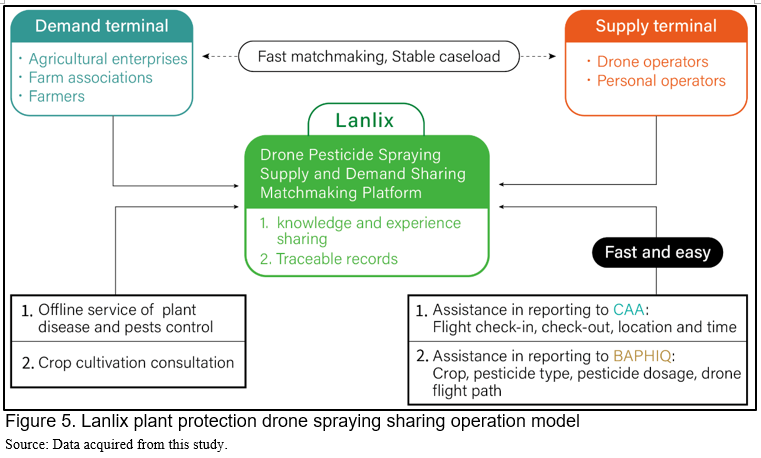
The above two cases describe the sharing of agricultural machineries in Taiwan. The first case resolves difficulties faced by small-scale farmers in acquiring large-scale agricultural machineries and addresses the problem of storage and shelving time of leafy vegetable crops by sharing the use of pre-coolers and storage space to reduce cost, thereby bringing maximum profit margins to farmers. The second case enables farmers to quickly match with suitable sprayers, reduce errors in using chemicals and procedures for uploading data, and increase the efficiency of using drones.
FEASIBLE FUTURE SHARING MODEL FOR TAIWAN’S AGRICULTURAL MACHINERY
Previously, Taiwan’s agricultural machinery farming system was mainly designed to meet the needs of the rice and grain industry. To extend this model to industries beyond rice and grains, such as the above-mentioned operation model, it is necessary to analyze different crops, regions, and user habits to understand the problems and challenges faced by each type of agricultural machinery in terms of applicable crops and user groups, so that an agricultural machinery sharing operation model that meets the needs of the industry can be developed. This study summarizes the existing cases of agricultural machinery sharing and the usage habits of agricultural machinery in Taiwan and further plans two types of sharing models, “stand-alone machine (dry lease)” and “machine plus personnel (wet-lease),” to be carried out by private enterprises for reference by the industry. The former is more applicable to small and medium-sized agricultural machinery, while the latter is more applicable to large agricultural machinery.
Stand-alone (dry lease) agricultural machinery sharing
Regardless of whether they are located domestically or overseas, agricultural machinery companies or agricultural machinery dealers have been leasing agricultural machineries on the Internet or in physical stores, most of which are small-scale agricultural machineries such as foggers, mowers, and tillage machines. However, because of the lack of open and transparent prices, leases such as reassurances of financial and logistic flows, and guarantees for the performance of agricultural machinery are still not popular in Taiwan, despite the market demand. Therefore, this study suggests constructing a dry-lease sharing model for agricultural machinery (Figure 6). By cooperating with small-scale agricultural machinery manufacturers or regional agricultural machinery dealers, a platform can be constructed to provide stand-alone equipment leasing and cleaning and machinery maintenance services. Other provisions include the expansion of leasing functions through this platform, such as rent-as-you-go, quotation, and insurance, to attract the original target customers to use the equipment. The rented farm equipment can be transported to the point of use by logistics or self-delivery and can be returned in the 
same way after use.

Machine plus personnel (wet-lease) agricultural machinery sharing
This model is primarily applicable to large-scale or expensive agricultural machineries, such as tractors, combined harvesters, and drones, among others, due to their high prices, complex operation, or the need for professional licenses to operate. In domestic and overseas cases, the farming service industry is required to provide technical personnel or experienced farmers with the ability to operate the machine, which is also the current mode of operation of the farming industry. How to enhance the machinery utilization rate efficiently is the key to developing the sharing model. Therefore, in the planning of the wet-lease sharing model, the man-machine cooperative leasing agricultural service model is strengthened (Figure 7), along with the cooperation between the platform and prominent agricultural machinery manufacturers/agents or regional agricultural machinery dealers/companies. Through the sharing system platform, businesses such as rent-as-you-go, quotation, and insurance are implemented to attract target customers. Their differences with a dry lease lie in that there should be more platforms that emphasize reservation and scheduling mechanisms. As this model is a service combining personnel and machinery, the platform provider will assist in transporting farm equipment to the point of use to meet the operators, and the lease contract will be finished upon completion of the on-site operation. In addition, the farm equipment can be installed with sensors to automatically collect information on the machine itself, the local conditions, and the climate during operation. The collected information will be sent back to the platform for storage and analysis to clearly grasp the condition and maintenance time of the machine, thus reducing the chance of making mistakes. The environmental status records of each transaction, such as land status and particular needs of the lessee, can be used to save the frequency and time of communication between different labor providers and lessees. The platform can also use such information to develop other businesses in the future.

The above-mentioned leasing or sharing models have different keys to success depending on the type of agricultural machinery and the way it is used. Taking the dry lease as an example, agents or agricultural machinery companies selling a wide variety of agricultural machinery are suitable to play the role of platform operators, and their business sites are located near farmlands, making rental and maintenance more convenient. However, a wet lease is more suitable for lease operators or agricultural service providers. The key partner is not only an operator who can provide farm equipment but also a person with professional agricultural machinery operation capability to cope with different terrain and geological changes and reduce agricultural machinery breakdowns. In addition, the number of operators, training, and scheduling planning is also essential issues for operators of wet-lease platforms.
CONCLUSION
As trust is a critical element in sharing economy, government-led agricultural sharing economy models, such as agricultural human resources groups, agricultural machinery Uber and farm banks, have been used to establish the credibility of the platforms in the past when the trust mechanism was not mature. However, nowadays, the operation mode of the sharing platform is becoming more mature. Identity authentication system, property claim system, matchmaking, bilateral commentary, and communication mechanism can all be handled through the platform. The transparency of relevant information also enhances the trust of both renters and lenders. The cases of agricultural machinery sharing presented in this study are all led by the private sector, which can also serve as a reference for promoting public-private partnerships or transferring related platforms to private enterprises for sustainable operation. The foundation for agricultural machinery sharing in Taiwan has already been laid under the rice contract farming system. The overall operation will be smoother if the sharing platform can be linked to auxiliary mechanisms such as financial flow, insurance, and information flow management. This model of agricultural machinery sharing can also be linked to the new agricultural machinery developed by Taiwan in the future, allowing farmers to experience the benefits of new and intelligent agricultural machineries, accelerating its spread, and enabling agricultural machinery developers to effectively obtain user feedback. It will also help the positive development of Taiwan’s agriculture and agricultural machinery industries.
REFERENCES
China National Information Center Sharing Economy Research Center (2020).” China Sharing Economy Development Report”. Beijing.
PwC (2016). “Assessing the size and presence of the collaborative economy in Europe”. UK.


An Exploration of the Current Agricultural Machinery Sharing Economy Model in Taiwan
ABSTRACT
With modern technology’s progress, the sharing economy model has become a business model actively popularized by various industries. The shortage and aging of the agricultural labor force have created an opportunity to accelerate the development of agricultural machinery sharing. Units under the Council of Agriculture have also established a system platform to assist farmers in deploying and matchmaking of agricultural machinery, expanding its service functions and conveniences. Non-governmental enterprises have also transformed vegetable vacuum pre-cooling and spraying services with drones into a model of agricultural machinery sharing. Finally, it is proposed that the future feasible agricultural machinery sharing can be divided into two types of sharing models: single machine and machine plus personnel, which can closely match the most suitable needs as well as the development of the industrial sector.
Keywords: agricultural machinery, Sharing Economy Model, farming service, pre-cooling equipment, drone spraying, dry lease, wet-lease
INTRODUCTION
In Taiwan, agricultural production is relatively small in scale, and the single producer resources are often limited. In contrast, a sharing economy model can be utilized in agriculture in terms of land, logistics, human resources and capital, and can lower the market entry barrier. In recent years, countries around the world have been facing a shortage of agricultural labor and aging issues, resulting in a significant increase in demand for agricultural mechanization and automation. Moreover, many agricultural machines are with high prices, plus their operating costs such as insurance, depreciation, maintenance, and storage are additional expenses after purchase. Apart from the cost of lands, the most significant cost of agricultural operation is agricultural machinery and equipment. Due to the change of demand and the development of the ICT industry, simple mechanization can no longer meet the needs of agricultural development, while agricultural machinery is gradually moving toward automation, motorization, and the integration of electrical and mechanical applications. To facilitate the development of Taiwan’s agricultural machinery sharing model, this paper introduces the international trend of sharing economy and current cases in Taiwan and explores the current development status of agricultural machinery sharing to establish a model which could be further developed based on such concept as a reference for future policy promotion.
SHARING ECONOMY DEVELOPMENT
With the increasing popularization of technologies and products such as the Internet of Things (IoT), big data, and mobile devices, sharing has become a business model aggressively pursued by various industries in recent years. According to a study, the total volume of sharing economic transactions in Europe in the areas of accommodation, transportation, work outsourcing services, and finance is estimated to proliferate from US$31.6 billion in 2015 to US$641 billion by 2025 (PwC, 2016), suggesting a rapid increase in the number of participants using sharing platforms for transactions. In addition, China has also actively set policies and targets for sharing economy promotion. In 2020, despite the impact of the COVID-19 pandemic, transactions in the sharing economy have still reached US$533.8 billion, with an overall growth rate of 2.9% compared to 2019 (Table 1), demonstrating the demand and potential of the sharing economy.
USAGE AND SHARING OF TAIWAN GOVERNMENT’S AGRICULTURAL MACHINERY
Taiwan’s agricultural sector is predominantly composed of small-scale farmers with a wide variety of crops and different crop growth periods. Large-scale agricultural machineries such as tractors and combined harvesters can cost tens to hundreds of thousands of US dollars (Figure 1); thus, maximizing the efficiency of these machines is a significant concern for farmers, while effective resource allocation across regions remains a significant challenge. Although small and medium-sized agricultural machinery may not command high prices, the cost of purchasing all agricultural machinery can be as high as US$3,200 to US$107,600 (Figure 2) depending on the type of land preparations, fertilization, pruning, harvesting, and transporting equipment required for different crops. However, many small agricultural machineries purchased are used only once or twice a year and are left idle for the rest of the year. It has led people to consider ways to replace ownership with access and reduce cost through sharing of agricultural machineries, leading to the gradual adoption of the sharing economy in the agricultural sector.
At present, in terms of the degree of automation of agricultural operations in Taiwan, the rice industry is the most well-established, with the degree of automation reaching 98%. In 2018, the Agriculture and Food Agency of the Council of Agriculture (COA) developed the Agricultural Machinery Farming Service Platform (also known as Agricultural Machinery Uber, https://eoi.afa.gov.tw/) on the basis of existing agricultural machinery farming networks. The platform assists farmers in all regions to locate the local operators through the website, improving the efficiency of agricultural machinery utilization and enhancing agricultural automation. At the same time, the Agency provided support to 14 counties and cities to establish “Agricultural Machinery Farming Service Associations,” of which more than 2,500 farmers are now members. In contrast, the associations can provide services such as deployment and matchmaking to meet farmers’ needs. For the purpose of expanding the functions and convenience of agricultural machinery services, farmers can also select agricultural services through the “Good Helpers for Agricultural Shortage” APP and the “Human Resources Platform” website (https://ahr.coa.gov.tw/), and rent the contents of farming services by selecting individual machines and human-machine combos, as shown in Figure 3.
USAGE AND SHARING OF AGRICULTURAL MACHINERY BY TAIWAN ENTERPRISES
Currently, a number of cooperatives and enterprises in Taiwan have already been planning and implementing agricultural machinery sharing. In particular, most of the agricultural machinery with the high unit price and low utilization rate can be economically shared to resolve the issue of idle assets, whereas the operation of some agricultural machinery requires professional personnel, so the agricultural machinery sharing model has gradually incorporated the element of human resources outsourcing. The following paragraphs will introduce two cases of agricultural machinery sharing in Taiwan and analyze their operation models.
Yunlin Xinshe Fruit and Vegetable Production Cooperative
Yunlin Xinshe Fruit and Vegetable Production Cooperative mainly targets the small farmers producing leafy vegetable crops. Due to the rather hot weather in Taiwan, if the field heat of fruits and vegetables is not removed right after their harvest, it will result in rapid yellowing and rotting of leafy vegetable crops. Therefore, it requires complete pre-cooling equipment and cold chain storage to extend the storage and shelving time. However, the high price of vacuum pre-cooling machines (costing US$276,000) is not affordable to small-scale farmers. Therefore, Yunlin Xinshe Fruit and Vegetable Production Cooperative established an online system platform that provides complete information such as online rental reservation, reservation scheduling, cold chain storage space purchase, real-time quotation, remote monitoring, access information records, etc. In addition, pre-cooling machine usage time and cold storage space can be reserved by APP and calculated by the number of boxes or pieces. This allows farmers to receive timely and transparent quotations. Moreover, some farmers do not have a large volume of vegetables after harvesting and need to pool them with other farmers to use them together, and this system allows the vacuum pre-cooler to be used with maximum efficiency (Figure 4).
Lanlix Corp Science Co., Ltd
Lanlix is a manufacturer and sales company of pesticides and fertilizers. The decline of Taiwan's agricultural population has led to a shortage of human resources and an aging population, and pest and disease control operations are gradually replacing human resources with drones. However, the following difficult points have been identified: (1) It's hard for the Bureau of Animal and Plant Health Inspection and Quarantine to monitor the flow direction of pesticides accurately; (2) Sprayers or individual operators cannot be reported accurately to the Civil Aeronautics Administration (CAA); (3) It is difficult to find suitable operators or individual pilots, often resulting in crop damage and injury. For this reason, Lanlix has designed a two-way supply and demand matching platform for agricultural spraying with plant protection drones, which helps to match the demand and supply terminals quickly. On the other hand, the spraying operators or individual pilots can get the commissioning information directly from the platform, reducing the error of communication. In addition, the platform can connect to the database of CAA and the Bureau of Animal and Plant Health Inspection and Quarantine for easy data uploading and traceability.Finally, this matchmaking platform establishes the offline connection between the pesticide agents and the plant disease and pests control system of Lanlix, and uses the technical support of pest identification and precision medication to create an innovative and complete the online and offline pesticide spraying service model for Taiwan (Figure 5.).
The above two cases describe the sharing of agricultural machineries in Taiwan. The first case resolves difficulties faced by small-scale farmers in acquiring large-scale agricultural machineries and addresses the problem of storage and shelving time of leafy vegetable crops by sharing the use of pre-coolers and storage space to reduce cost, thereby bringing maximum profit margins to farmers. The second case enables farmers to quickly match with suitable sprayers, reduce errors in using chemicals and procedures for uploading data, and increase the efficiency of using drones.
FEASIBLE FUTURE SHARING MODEL FOR TAIWAN’S AGRICULTURAL MACHINERY
Previously, Taiwan’s agricultural machinery farming system was mainly designed to meet the needs of the rice and grain industry. To extend this model to industries beyond rice and grains, such as the above-mentioned operation model, it is necessary to analyze different crops, regions, and user habits to understand the problems and challenges faced by each type of agricultural machinery in terms of applicable crops and user groups, so that an agricultural machinery sharing operation model that meets the needs of the industry can be developed. This study summarizes the existing cases of agricultural machinery sharing and the usage habits of agricultural machinery in Taiwan and further plans two types of sharing models, “stand-alone machine (dry lease)” and “machine plus personnel (wet-lease),” to be carried out by private enterprises for reference by the industry. The former is more applicable to small and medium-sized agricultural machinery, while the latter is more applicable to large agricultural machinery.
Stand-alone (dry lease) agricultural machinery sharing
Regardless of whether they are located domestically or overseas, agricultural machinery companies or agricultural machinery dealers have been leasing agricultural machineries on the Internet or in physical stores, most of which are small-scale agricultural machineries such as foggers, mowers, and tillage machines. However, because of the lack of open and transparent prices, leases such as reassurances of financial and logistic flows, and guarantees for the performance of agricultural machinery are still not popular in Taiwan, despite the market demand. Therefore, this study suggests constructing a dry-lease sharing model for agricultural machinery (Figure 6). By cooperating with small-scale agricultural machinery manufacturers or regional agricultural machinery dealers, a platform can be constructed to provide stand-alone equipment leasing and cleaning and machinery maintenance services. Other provisions include the expansion of leasing functions through this platform, such as rent-as-you-go, quotation, and insurance, to attract the original target customers to use the equipment. The rented farm equipment can be transported to the point of use by logistics or self-delivery and can be returned in the
same way after use.
Machine plus personnel (wet-lease) agricultural machinery sharing
This model is primarily applicable to large-scale or expensive agricultural machineries, such as tractors, combined harvesters, and drones, among others, due to their high prices, complex operation, or the need for professional licenses to operate. In domestic and overseas cases, the farming service industry is required to provide technical personnel or experienced farmers with the ability to operate the machine, which is also the current mode of operation of the farming industry. How to enhance the machinery utilization rate efficiently is the key to developing the sharing model. Therefore, in the planning of the wet-lease sharing model, the man-machine cooperative leasing agricultural service model is strengthened (Figure 7), along with the cooperation between the platform and prominent agricultural machinery manufacturers/agents or regional agricultural machinery dealers/companies. Through the sharing system platform, businesses such as rent-as-you-go, quotation, and insurance are implemented to attract target customers. Their differences with a dry lease lie in that there should be more platforms that emphasize reservation and scheduling mechanisms. As this model is a service combining personnel and machinery, the platform provider will assist in transporting farm equipment to the point of use to meet the operators, and the lease contract will be finished upon completion of the on-site operation. In addition, the farm equipment can be installed with sensors to automatically collect information on the machine itself, the local conditions, and the climate during operation. The collected information will be sent back to the platform for storage and analysis to clearly grasp the condition and maintenance time of the machine, thus reducing the chance of making mistakes. The environmental status records of each transaction, such as land status and particular needs of the lessee, can be used to save the frequency and time of communication between different labor providers and lessees. The platform can also use such information to develop other businesses in the future.
The above-mentioned leasing or sharing models have different keys to success depending on the type of agricultural machinery and the way it is used. Taking the dry lease as an example, agents or agricultural machinery companies selling a wide variety of agricultural machinery are suitable to play the role of platform operators, and their business sites are located near farmlands, making rental and maintenance more convenient. However, a wet lease is more suitable for lease operators or agricultural service providers. The key partner is not only an operator who can provide farm equipment but also a person with professional agricultural machinery operation capability to cope with different terrain and geological changes and reduce agricultural machinery breakdowns. In addition, the number of operators, training, and scheduling planning is also essential issues for operators of wet-lease platforms.
CONCLUSION
As trust is a critical element in sharing economy, government-led agricultural sharing economy models, such as agricultural human resources groups, agricultural machinery Uber and farm banks, have been used to establish the credibility of the platforms in the past when the trust mechanism was not mature. However, nowadays, the operation mode of the sharing platform is becoming more mature. Identity authentication system, property claim system, matchmaking, bilateral commentary, and communication mechanism can all be handled through the platform. The transparency of relevant information also enhances the trust of both renters and lenders. The cases of agricultural machinery sharing presented in this study are all led by the private sector, which can also serve as a reference for promoting public-private partnerships or transferring related platforms to private enterprises for sustainable operation. The foundation for agricultural machinery sharing in Taiwan has already been laid under the rice contract farming system. The overall operation will be smoother if the sharing platform can be linked to auxiliary mechanisms such as financial flow, insurance, and information flow management. This model of agricultural machinery sharing can also be linked to the new agricultural machinery developed by Taiwan in the future, allowing farmers to experience the benefits of new and intelligent agricultural machineries, accelerating its spread, and enabling agricultural machinery developers to effectively obtain user feedback. It will also help the positive development of Taiwan’s agriculture and agricultural machinery industries.
REFERENCES
China National Information Center Sharing Economy Research Center (2020).” China Sharing Economy Development Report”. Beijing.
PwC (2016). “Assessing the size and presence of the collaborative economy in Europe”. UK.